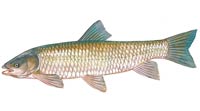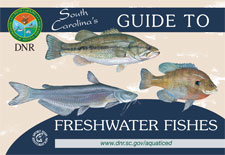Freshwater Fish - Species
Grass carp or White amurp
Freshwater Fishing License required.
Regulations:
It is unlawful to take, harm or kill grass carp in public waters.
Grass carp or White amur (Ctenyopharyngodon idella)
Description: (Anatomy of a Fish)
The grass carp has a thick, mullet-like body with a white head and a terminal mouth. The scales are large with dark edges. The dorsal and pectoral fins start at the same midway point along the body almost appearing parallel. The grass carp’s body can range from silvery to olive in color on its back fading to a yellow and white below.
Range: Scattered within the Pee Dee to the Savannah River, mostly in the Coastal Plain. Not native to South Carolina.
Average Length: 2-3 feet
Average Size: 3-15 pounds, may exceed 40 pounds
South Carolina State Record: Unknown
Life Expectancy: Unknown
Preferred Habitat
Grass carp prefer quiet or slow-moving water in ponds, lakes, pools and backwaters of large rivers.
Food Habits
- Young grass carp eat small invertebrates and microcrustaceans. As they become adults, they become predominantly herbivores feeding voraciously on aquatic plant species.
Spawning
- Grass carp introduced here are tested to be sterile triploids and thus cannot reproduce, but they can commonly be found over shoals where they typically would lay and fertilize eggs.
Miscellaneous
Grass carp are native to eastern Asia, but were introduced in the United State in 1963 first in Alabama and Arkansas. This non-native fish now occurs in 35 states. Grass carp were introduced to help control nuisance or invasive aquatic vegetation. Large grass carp can consume many pounds of aquatic vegetation in a day. However, due to their rapid growth rate, voracious appetite and high reproduction rates, fisheries managers who introduced the species realized they could have adverse impact on native fish and plant species. Therefore, they mandated only sterile triploids could be introduced. A permit is required from the South Carolina Department of Natural Resources to sell, buy, or posses any grass carp even sterile triploids. In the permitting process, SCDNR certifies the grass carp hybrids have been tested and determined to be sterile.
Commonly Mistaken Species
Some species of fish that are commonly mistaken for this species are:
More information
Literature Cited
Rohde, Fred C, Arndt, Rudolf G., Foltz, Jeffery W., Quattro, Joseph M. 2009. Freshwater Fishes of South Carolina. University of South Carolina Press, Columbia, South Carolina.
Wildlife and Freshwater Fisheries Division. 2009. South Carolina Guide to Freshwater Fishes.
Fish Illustration by Duane Raver.


